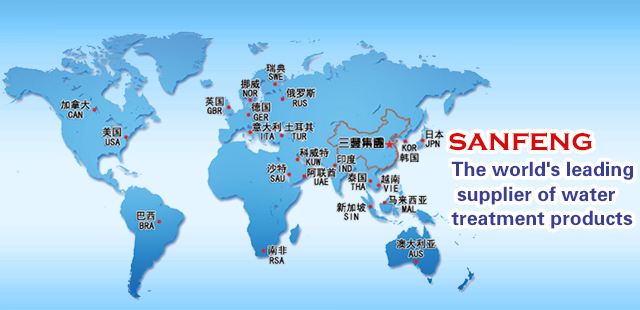The top of the form
1 topic content and scope of application
This standard specifies aluminium sulfate treatment for the technical requirements, test methods, inspection rule and marks, packaging, transport and storage requirements.
This standard is suitable for water treatment aluminium sulfate (solid, solution). This product is mainly used for drinking water and industrial water treatment.
Molecular formula: Al2 (SO4) 3 · H20
Relative molecular mass [Al2 (SO4) 3 meter] : 342.15 (in 1987 the international relative atomic mass)
2 reference standard
GB19l packaging graphic symbol
GB601 chemical reagent titration analysis (capacity) in the preparation of standard solution
GB602 chemical determination of impurities in the preparation of standard solution
GB603 chemical reagent test method used in the formulation and preparation of products
GB6l0. 1 arsenic chemical reagent use-general method (arsenic spot method)
GB3049 chemical products general method for the determination of iron content in adjacent phenanthroline spectrophotometric method
GB6678 chemical products sampling conditions
3 technical requirements
3.1 appearance: solid product is white or microstrip gray granular or massive. For micro, gray green or micro solution products.
3.2 water treatment agent aluminium sulfate should conform to the requirements of the table l.
Table 1
| Indicators project | Indicators project | ||
| solid | solution | ||
| Grade a | Nonconforming product | ||
| Al2O3 content,%≥ | 15.60 | 15.60 | 7.8 |
| Fe content,%≤ | 0.52 | 0.70 | 0.25 |
| Water content,%≤ | 0.15 | 0.15 | 0.15 |
| pHvalue(1%Aqueous solution),≥ | 3.0 | 3.0 | 3.0 |
| As content,%≤ | 0.0005 | 0.0005 | 0.0003 |
| Heavy metal(Pb)content,%≤ | 0.002 | 0.002 | 0.001 |
4 test method
Reagents and water used in this standard, when did not indicate the other requirements, refers to the analytical reagent and distilled water or equivalent purity of the water.
Tests required standard solution, standard solution, preparation of impurities and products, without indicate the other provisions, all press GB601, GB602, the provisions of GB603 preparation.
4.1 the determination of alumina content
4.4.1 methods feed
Aluminum in a sample with known excessive ethylenediamine tetraacetic acid disodium reaction, generate complex. When pH is about 6, with xylenol orange as the indicator, with zinc standard titration solution titration of excessive ethylenediamine tetraacetic acid disodium.
4.1.2 reagents and materials
4.1.2.1 sodium acetate (GB693) solution: 272 g/L;
4.1.2.2 zinc chloride (HG3-947) standard titration solution: c (ZnCl2) 0.02 mol/L;
4.1.2.3 ethylenediamine tetraacetic acid disodium salt (EDTA) (GB1401) standard titration solution: c (C10H14O8N2Na2) is about 0.05 mol/L.
4.1.2.4 xylenol orange: 2 g/L solution;
4.1.3 analysis steps
Say about 5 g of solid sample or sample 10 g solution, accurate to 0.0002 g, put in 250 ml beaker, with about 100 ml water heating to dissolve (filtering) when necessary, after cooling, all transfer into 500 ml volumetric flask and diluted to scale, shake well.
With a pipette 20 ml of the test solution, in a 300 ml conical flask. With a pipette to join 20 mledta standard titration solution, boil 1 min, add 5 ml of sodium acetate solution after cooling and 2 xylenol orange indicator drops. With zinc chloride standard titration solution titration to pale pink.
At the same time do a blank test.
4.1.4 analysis results
To the quality expressed as percentage content of alumina (Al2O3) X1 calculated by type (1) :
X1 = 0.05098 (where V0 - V)/c (m (20/500) x 100-0.9128 - X2
(where V0 - V) = 127.5 c/m - 0.9128 - X2........................ (1)
Type: c - the actual concentration of zinc chloride standard titration solution, mol/L;
Where V0 one by one blank test consumed zinc chloride standard titration solution volume, mL;
V - a test solution consumed zinc chloride standard titration solution volume, mL;
M sample quality, g;
Article 4.2 X2 - a measure of the content of iron (Fe), %;
0.05098 - and 1.00 mL ethylenediamine tetraacetic acid disodium standard titration solution (C10H14O8N2Na2) = 1.000 mol/L [c] quite, to the quality of the alumina (Al2O3) said;
0.9128 one iron (Fe) conversion into alumina (Al2O3) coefficient.
The results should be said to two decimal places.
4.1.5 allow poor
The difference between the two parallel determination results is not more than 0.15%, take the arithmetic mean as the determination results.
4.2 the determination of iron content
2 way to feed
With GB3049 article 2.
4.2.2 reagents and materials
With GB3049 article 3.
Holdings instruments and equipment
4.2.3.1 spectrophotometer: absorption cell with a thickness of 1 cm.
4.2.4 working curve drawing
According to the provisions of the article 5.3 of the GB3049 use 1 cm iron absorption cell and the corresponding standard solution dosage, working curve drawing.
4.2.5 analysis steps
4.2.5.1 test solution preparation
Said about 3 g or 5 g sample solid solution sample, accurate to 0.01 g, put in 250 ml beaker, add 100 ml water and 2 ml of hydrochloric acid (1 + 1), heat dissolved and boil 5 min, after cooling all transfer into 500 ml volumetric flask and diluted to scale, shake well.
4.2.5.2 blank test solution preparation
Add 100 ml to 250 ml beaker of water and 2 ml of hydrochloric acid (1 + 1), heat and boil 5 min, after cooling all transfer into 500 ml volumetric flask and diluted to scale, shake well.
Determination of 4.2.5.3
Move with a pipette 5 ml test solution (4.2.5.1) and 5 ml (4.2.5.2), blank test solution, respectively, in the 100 ml beaker. According to provisions of article 5.4 of the GB3049 below, from "when necessary, add water to 60 ml......" To begin operations.
4.2.6 analysis results
To the quality expressed as percentage content of iron (Fe) X2 calculated by type (2) :
X2 = (- m0, m1)/(1000 m * 1000 * 5/500) = 10 (m1 - m0)/m........................ (2)
Type: m1 one by one according to the measured absorbance test solutions, find out from the working curve of iron content, mg;
M0 one by one according to the measured the absorbance of the blank test solution, find out from the working curve of iron content, mg;
M - sample quality, g.
The results should be said to two decimal places.
4.2.7 allow poor
The difference between the two parallel determination results is not more than 0.03%, take the arithmetic mean as the determination results.
4.3 water insolubles content determination
This method is the feed
Water to dissolve sample, with the crucible type filter, the dry residue after weighing.
4.3.2 reagents and materials
4.3.2.1 barium chloride (BaC12 · 2 h2o) (GB652) solution: 100 g/L.
4.3.3 instruments and equipment
4.3.3.1 crucible filter: filter plate aperture is 5 ~ 15 microns.
4.3.4 analysis steps
According to take about 20 g sample, accurate to 0.01 g, put in 250 ml beaker, add 100 ml water, heat to dissolve. Strike with in 105 ~ ll0 ℃ drying to constant weight of crucible type filter, wash in hot water until no sulfuric acid root ion (with barium chloride solution test) in 105 ~ ll0 ℃ under dry to constant weight.
4.3.5 analysis results
Expressed in weight percent of water insolubles content according to the type (3) :
X3 = (m2 - m1)/m x 100.......................................... (3)
Type: m1 - crucible filter quality, g;
M2 a monohydrate insolubles and crucible filter quality, g;
M sample quality, g.
The results should be said to two decimal places.
4.3.6 allow poor
The difference between the two parallel determination results is not more than 0.02%, take the arithmetic mean as the determination results.
The determination of pH 4.4
4.4.1 methods feed
Sample is dissolved in water, with a glass electrode and calomel reference electrode of the pH of the solution acidity meter measurement test.
4.4.2 instruments and equipment
4.4.2.1 acidity meter: dividing value is 0. LpH units, equipped with glass measuring electrode and saturated calomel reference electrode.
4.4.3 analysis steps
Said to take 1.00 + 0.01 g sample, put in 100 ml beaker, add 50 ml contains no dissolved carbon dioxide water, all transfer into 100 ml volumetric flask, use do not contain carbon dioxide water diluted to scale, shake well. Test the pH of the solution is measured with a pH meter.
The results obtained shall be said to a decimal.
4.4.4 allow poor
The difference between the two parallel determination results is not more than 0.2 pH unit, take the arithmetic mean as the determination results.
4.5 the determination of arsenic content
4.5.1 methods feed
In acid medium, metal zinc will arsenic reduction for hydrogen arsenide. Hydrogen arsenide evolution of mercury in tan arsenic spot is formed on the test paper, comparing with standard arsenic spot.
4.5.2 of reagents and materials
4.5.2.1 hydrochloride (GB622);
4.5.2.2 potassium iodide (GB1272);
4.5.2.3 arsenic-free zinc (GB2304);
4.5.2.4 stannous chloride (GB638) solution: 400 g/L;
4.5.2.5 arsenic standard solution: 0.0010 mgAs/mL. After press GB602 preparation, use pipette moves take 10 ml, put in 1000 ml volumetric flask, diluted to scale, shake well.
4.5.2.6 lead acetate cotton;
Mercury 4.5.2.7 bromide paper.
4.5.3 instruments and equipment
4.5.3.1. Fixed arsenic: according to the specified in the GB6l0 figure l device.
4.5.4 analysis steps
Said to take about 5 g sample, accurate to 0.0 lg, dissolves, all transfer into 100 ml volumetric flask and diluted to scale, shake well.
With a pipette 20 ml test solution, put in jars. Add 5 ml of hydrochloric acid, potassium iodide 1 g and 5 drops of stannous chloride solution, shake well placed after 10 min. Add 2 g no zinc, arsenic will have installed immediately lead acetate cotton and mercury bromide paper glass tube is installed and plugged. Placed under 25 ~ 30 ℃ in the dark for 1 h. Remove mercury bromide paper, the color shall not be deeper than the standard.
Standards are: for solid aluminum sulfate, using pipette 5 ml arsenic standard solution; For aluminium sulfate solution, with a pipette moves take 3 ml arsenic standard solution, add water to 20 ml, with the test solution at the same time.
4.6 the determination of heavy metal content
4.6.1 methods feed
In acidic medium, heavy metal ions react with hydrogen sulfide solution, the solution is tan, comparing with standard solution.
4.6.2 reagents and materials
4.6.2.1 ice acetic acid solution (GB676) : 1 + 2 solution.
4.6.2.2 saturated h2s water: current chef;
4.6.2.3 hydroxylamine hydrochloride solution (HG3-967) : 200 g/L;
4.6.2.4 lead standard solution: 0.0 l0mgPb/mL, take according with pipette GB602 preparation before removing 10 mL, put in 100 mL volumetric flask, diluted to scale, shake well.
4.6.3 instruments and equipment
4.6.3.1 colorimetric tube: 50 ml.
4.6.4 analysis steps
Say about 5 g of solid sample or sample 10 g solution, accurate to 0.0 lg, put in 250 ml beaker, add right amount water to dissolve, all transfer into 100 ml volumetric flask and diluted to scale, shake dry filter (necessary).
Use pipette to move 20 mL test solution, put in 50 mL colorimetric tube, add 0.5 mL of acetic acid solution, 5 mL of hydroxylamine hydrochloride solution, opening shaking 10 min, add 10 mL of saturated hydrogen sulphide water, add water to the scale, shake well. Test solution assumes the color may not be deeper than the standard.
Standard is: use pipette to move 2 ml lead standard solution, and the sample at the same time.
5 inspection rules
5.1 water treatment agent aluminium sulfate by quality supervision and inspection department of factory inspection according to the provisions of this standard. Manufacturer shall ensure that all water treatment aluminium sulfate factory conform to the requirements of this international standard. Every batch of factory products shall be accompanied by a certificate of quality, include: name of the manufacturer, product name, rank, batch number, net weight, production date, product quality and the standard of the evidence of compliance with this standard number.
5.2 using unit shall have the right to according to the provisions of this standard to the received water treatment agent aluminium sulfate for acceptance. Acceptance shall be the date of arrival of the goods within 15 days.
5.3 each batch products weight not exceeding 100 t. Solution product tank, a tanker as one batch.
According to provisions of article 6.6 of the GB6678 5.4 determine the number of sampling units,
Solid product sampling, first remove the bags about 30 cm of the upper material layer, using the sampling tool to take samples of not less than 100 s, samples from which will quickly broken below about 10 mm, blending. According to the method of four points are classified to about 500 g, partial shipments in two clean, dry and belt grinding plug in the jar, sealed, paste the label on the bottle. Indicate: factory name, product name, grade, batch number, date of sampling and sample name, bottle used for inspection, another bottle of save for future reference of 3 months.
Bulk solution product sampling, use sampler from top, middle and lower three layers according to 1:3:1 sampling. With tanker loading, with sampler inlet from the top, middle and lower parts according to 1:3:1 sampling. At the top can't sampling and the material is uniform, but in the discharging mouth of the tanker samples. The specimen shall be not less than 500 ml. After blending, in a clean, dry glass bottle, paste the label on the bottle. Indicate: factory name, product name, grade, batch number and date of sampling, inspection department.
5.5 if the test result was a indicators do not meet the requirements of this standard, should be back from two times the amount of packaging in the sampling check, check the result even if only one of indicators do not meet the requirements of this standard, the whole batch of products can't acceptance.
5.6 when supply and demand both sides dispute occurs, the quality of product in accordance with the interim measures for the national product quality inspection arbitration provisions.
6 marks, packaging, transport and storage
6.1 packaging containers should have a sign of strong, clear, indicate: name of the manufacturer, product name, rank, net weight, batch number or production date, trademarks and the standard number.
Liquid products shall, in accordance with the provisions of xu brush GB19l (figure 3) sign up,
6.2 water treatment agent aluminium sulfate (solid) in plastic woven bag lined with polyethylene plastic bags or composite plastic woven bag packing. Each bag net weight 50 kg.
Water treatment agent of aluminium sulfate solution with FRP tank or plastic (net weight of 25, 30 or 35 kg) packaging.
6.3 the goods transportation, prevent toxicant pollution and be affected with damp be affected with damp.
6.4 this product should be stored in ventilated dry place, prevent the rain be affected with damp be affected with damp,
Additional instructions:
This standard by the ministry of chemical industry of the People's Republic of China, slurry sampling is proposed.
This standard by the ministry of chemical industry in tianjin chemical industry research institute and Chinese academy of preventive medicine under centralized by environmental health monitoring.
This standard by the ministry of chemical industry in tianjin chemical research institute is responsible for drafting.
Main drafter of this standard Zhou Qiaoe, XingYuFen.
With reference to this standard by the American association of tap water standard ANSI/AWWAB403-82 aluminum sulfate - liquid, granular and lump.
Since the date of implementation of this standard. The original national standard GB3l5l - 82 "water purifier aluminium sulphate"
Form the bottom of the















